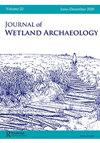Chronology, Culture and Archaeology: Precision Chronology of Wetland Structures Using Tree-Ring Studies
Q1 Arts and Humanities
引用次数: 2
Abstract
Over the last couple of decades, survey of the estuaries of Irish rivers, particularly around the Shannon and Fergus estuaries in Co. Clare, has produced a wealth of inter-tidal remains of structures that attest to the exploitation of resources in this marginal zone, through time (O’Sullivan, 2001; 2003). More recent discoveries in the Fergus estuary, funded by the Irish Heritage Council, have led to a series of research projects, investigating these remains to an increasing level of detail (Dillon and O’Sullivan, 2008; O’Sullivan and Dillon, 2009; O’Sullivan, et al. 2010; Sands, et al. 2012). A two-year project entitled ‘Chronology, Culture and Archaeology’, was funded through the Marie Curie Actions – Intra-European Fellowships for Career Development (IEF). It was concerned with establishing the fine-tuned chronology of the fishing structures at a specific site on the Fergus estuary – at Boarland Rock, using tree-ring studies. The very young trees that had been used to build a series of medieval fishweirs at Boarland Rock present a considerable chronological challenge. While the technique of dendrochronology provides precise calendar dates for timber it is dependent on the discovery of objects or structures made from long-lived trees, to ensure reliable results. When a structure is only made from short-lived trees the creation of an absolute chronology is impossible. However, this does not necessarily mean that the data locked within those tree rings is of no use. It remains possible that a relative chronology can be constructed and the pattern of repair and rebuilding of the fishweirs can be revealed, leading to a better understanding of their duration and change. As part of the research, select international colleagues, all of whose research combines study of wetland archaeology and tree-ring analysis, were invited as advisors, during the project. These were Vincent Bernard, Andre Billamboz, Anne Crone, and Nigel Nayling. In September 2012 this group gathered in Dublin, to hear the results of the Marie Curie and Fergus Estuary Projects, to see the sites on the Fergus estuary, to lend their esteemed advice and to present the current state of research in tree-ring study of wetland archaeological sites. While Nayling’s study of the inter-tidal structures at Magor Pill is fully published (Nayling, 1996; 1999) journal of wetland archaeology, Vol. 14, September 2014, 1–5年代学、文化与考古学:利用树木年轮研究湿地结构的精确年代学
在过去的几十年里,对爱尔兰河流河口的调查,特别是在克莱尔郡的香农河口和费格斯河口附近,发现了大量的潮间带遗迹,这些遗迹证明了这一边缘地带的资源被长期开发利用(O 'Sullivan, 2001;2003)。最近在费格斯河口的发现,由爱尔兰遗产委员会资助,导致了一系列的研究项目,对这些遗骸进行了越来越详细的调查(Dillon和O 'Sullivan, 2008;O 'Sullivan and Dillon, 2009;O 'Sullivan, et al. 2010;Sands等人,2012)。一个名为“年代学、文化和考古学”的为期两年的项目由居里夫人行动-欧洲内部职业发展奖学金(IEF)资助。它的目的是利用树木年轮研究,在弗格斯河口的一个特定地点- - Boarland Rock - -建立精细调整的捕鱼结构年表。这些非常年轻的树木曾被用来在Boarland Rock建造一系列中世纪的鱼塘,这对时间构成了相当大的挑战。虽然树木年代学技术为木材提供了精确的日历日期,但它依赖于发现由长寿树木制成的物体或结构,以确保可靠的结果。当一个结构只由寿命较短的树木构成时,创造一个绝对的年表是不可能的。然而,这并不一定意味着锁定在这些树木年轮中的数据毫无用处。仍然有可能构建一个相对的年表,揭示鱼塘修复和重建的模式,从而更好地了解它们的持续时间和变化。作为研究的一部分,项目期间邀请了一些国际同事作为顾问,他们的研究都结合了湿地考古学和树木年轮分析的研究。他们是文森特·伯纳德、安德烈·比兰博兹、安妮·克罗恩和奈杰尔·奈林。2012年9月,这个小组聚集在都柏林,听取了居里夫人和费格斯河口项目的结果,参观了费格斯河口的遗址,提出了他们尊敬的建议,并介绍了湿地考古遗址树木年轮研究的现状。虽然Nayling对Magor Pill潮间带结构的研究已经完全发表(Nayling, 1996;1999)湿地考古学报,第14卷,2014年9月,1-5
本文章由计算机程序翻译,如有差异,请以英文原文为准。
求助全文
约1分钟内获得全文
求助全文
来源期刊

Journal of Wetland Archaeology
Arts and Humanities-Archeology (arts and humanities)
CiteScore
1.40
自引率
0.00%
发文量
6
期刊介绍:
The Journal of Wetland Archaeology publishes a wide range of contributions in all fields of wetland archaeology. It includes scientific and methodological features, geoprospection, environmental reconstruction, wetland hydrology, cultural aspects of wetland archaeology, as well as conservation, site management, legislation, and site protection. All periods and all geographic regions are covered.
 求助内容:
求助内容: 应助结果提醒方式:
应助结果提醒方式:


